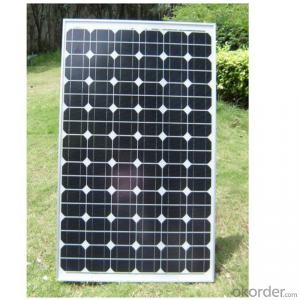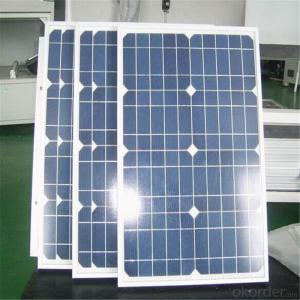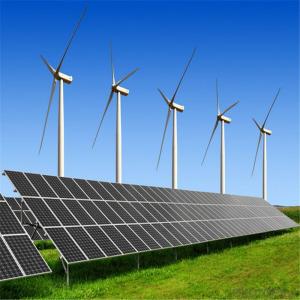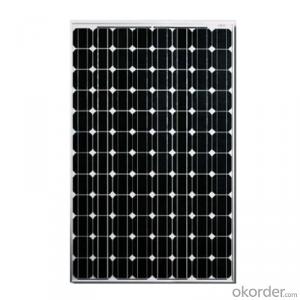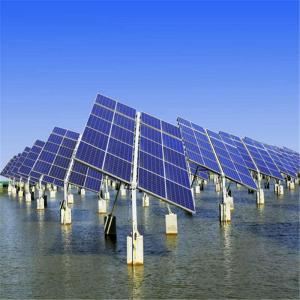Best Solar Panels for Hot Climates - High Efficiency Mono Solar Panel Made in China ICE-03
- Loading Port:
- China main port
- Payment Terms:
- TT OR LC
- Min Order Qty:
- 200 watt
- Supply Capability:
- 50000 watt/month
OKorder Service Pledge
OKorder Financial Service
You Might Also Like
Instruction
Format : 156 mm × 156 mm ± 0.5 mm
Thickness: 210 μm ±40 μm
Front (-) : 1.5mm bus bars (silver),blue anti-reflection coating (silicon nitride)
Back (+) : 2.5mm wide soldering pads (silver) back surface field (aluminium)
Feature
1. High efficiency and High power.
2. Long-term electrical stability.
3. Lowest price and Fastest delivery.
4. Good quality and best service.
5. Bulk supply
6. Trusted Warranty
7. Big Sale
8. More than 25 years on the lifetime.
Images
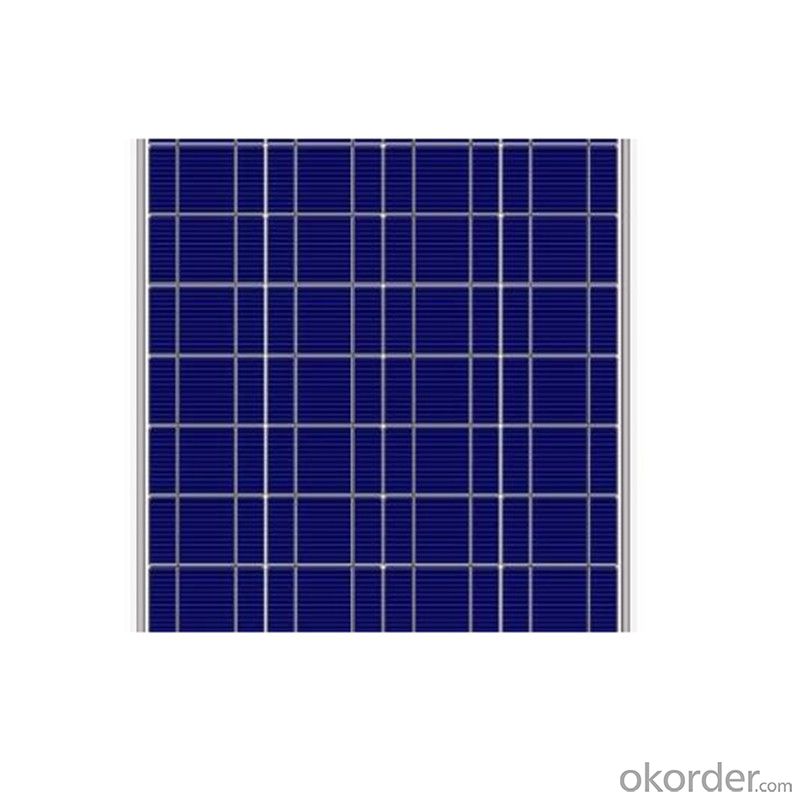
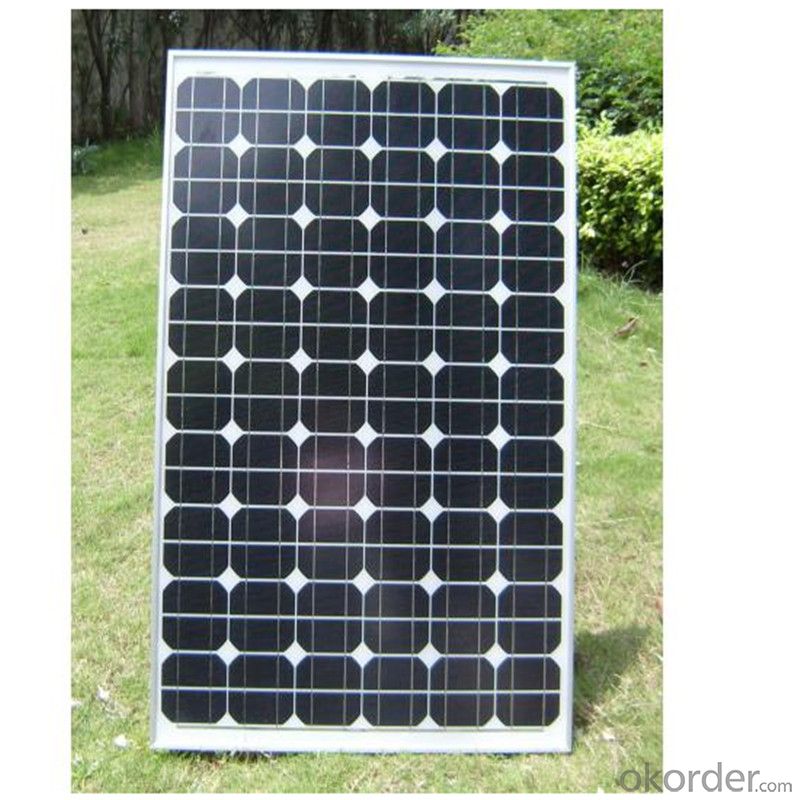
Specification
Electrical Characteristic of Mono Solar Cells
Model Type | |
Peak Power-Pmax(W) | 185 |
Open Circuit Voltage-Voc(V) | 44.2 |
Maximum Power Voltage-Vmp(V) | 36 |
Short Circuit Current-Isc(A) | 5.4 |
Maximum Power Current-Imp(A) | 5 |
Maximum System Voltage | 1000V DC |
Maximum Series Fuse Rating | 10A |
Power Tolerance | -1~+3% |
Temperature Coefficients of Pmax | -0.45%/℃ |
Temperature Coefficients of Voc | -0.348%/℃ |
Temperature Coefficients of Isc | 0.031%/℃ |
Nominal Operating Cell Temperature | 44.5±2℃ |
Standard Testing Condition(STC) | Irradiance:1000W/m²;Temperature:25℃;AM=1.5 |
Qualification Test Parameters | |
Operating Temperature | -40℃~+85℃ |
Storage Temperature | -40℃~+85℃ |
Pressure Bearing | ≥5400Pascal/m² |
Wind Bearing | ≥5400Pascal/m² |
Mechanical Characteristics | |
Cell Size | Mono 125*125mm±0.5 |
No.of Cells | 72pcs(6*12) |
FAQ
We have organized several common questions for our clients,may help you sincerely:
1. What’s price per watt?
A: It’s depends on the quantity, delivery date and payment terms of the order. We can talk further about the detail price issue. Our products is high quality with lower price level.
2. Can you tell me the parameter of your solar cells?
We have different series of cells with different power output, both from c-si to a-si. Please take our specification sheet for your reference.
3. How do you pack your products?
We have rich experience on how to pack the panels to make sure the safety on shipment when it arrives at the destination.
- Q: I am searching for producers or distributors of solar panels. Thanks!
- There are ton's of distributor around that can provide you a cheap solar panel that didn't came from China. Expand your knowledge and learn from a renowned solar company about the Best Solar Panels. Visit our site and contact us today!
- Q: Can solar panels be used in combination with wind turbines?
- Yes, solar panels can be used in combination with wind turbines. This combination is known as a hybrid renewable energy system, which allows for a more consistent and reliable power generation. By harnessing both solar and wind energy, the system can maximize electricity production and provide a more sustainable solution for meeting energy needs.
- Q: Can anyone give me a link to a website that sells really big solar panels? Enough to run a small cafe on entirely solar power.
- I think you may be surprised how much energy a little cafe like that uses. Since the air conditioning, refrigerators, and other appliances are going nonstop, I'd expect the energy usage to be several times that of a normal house. If you have access to the electric bills of the cafe while it was in operation, look up the kWh's used per month. For scale, I will say that our house uses 500 kWh per month, and needs 3 kW of panels to keep up with that. Scale up to match the restaurant, as a ballpark estimate. If you don't have access to the electric bills, then go visit a similar cafe in town, or a nearby town, and ask them how much their electric bill is. If the ballpark estimate still looks doable to you, then contact a professional solar installer to get an accurate, no-obligation estimate. Most likely, the cafe will use gas heat for cooking. But if not, electricity from solar panels is probably the most inefficient way to cook. Consider having solar ovens for most of the cooking, if you have land, with gas as a backup on cloudy days.
- Q: Are there any tax credits available for installing solar panels?
- Yes, there are tax credits available for installing solar panels.
- Q: I have:4- 5v 200ma solar panels5- 3v ,000ma solar panels- 7amp charge controller- 400watt inverterNow I have all my solar panels linked in series which in theory should give me 35v, 5.8 amps at 203 watts. Is this correct?The main question is, what kind of battery should I get so I can run my miscellaneous electronics off of it?I may not have explained it so well so if you need more information, feel free to ask.
- I okorder and they have deep cycle batteries exclusively made for solar panels. but in theory you should get more than one because it only takes around 4-5 volts to charge the battery and you do not want to have it that high even with a charge controller which i would also recommend getting which is like $50 on OKorder but a charge controller is used so you do not overcharge the batteries and fry them or undercharge the batteries and weaken its life it gets it just perfect. it lets the current go in and when it is charged fully nothing goes in an nothing comes out.... for a inverter the one i was going to get was $70 500 watt inverter but changes it from dc to ac...hope i helped
- Q: Can someone tell me if I can run a air conditioner off solar panel?I have a ET-P65420 20Wp solar panel. What do I need to make it work? I am told I will need a Enphase Energy Microinverter M20. Is that true? I am looking to run a 5000 to 8000btu air conditioner to a max of 0000btu air conditioner. I need to cool a 0x30 space. One time I read, I need total watts of panel to match total watts of air conditioner. Then I read, that I do not and can run more watts then what the panel is depending on the inverter and batteries.Can someone tell me what and how to make this work please? More panes or inverter and batteries?
- This Site Might Help You. RE: Run a air conditioner off solar panel? Can someone tell me if I can run a air conditioner off solar panel? I have a ET-P65420 20Wp solar panel. What do I need to make it work? I am told I will need a Enphase Energy Microinverter M20. Is that true? I am looking to run a 5000 to 8000btu air conditioner to a max of 0000btu air...
- Q: Green issues aside, are solar panels worth it, monetarily speaking?I don't mean that my house might be worth more or any of that. All I am asking is this: if I invest in a set of solar panels, will the cost be paid back to me over time? If so, how long will it takegt;Take into account the following:. Currently I pay the electric company around $00 per month2. I use around 400 kilowats of energy per monthI realize that exact numbers are hard to come by, but any opinions are welcome.
- Build okorder
- Q: okay so i want to know if solar panels shine. ------(MY Q'S ABOUT BLINDNESS DOESN'T MEAN PERMANENT OMG I CAN'T SEE! BLIND BUT THAT WE JUST CANquot;T SEE AT THE MOMENT BECAUSE OF THE LIGHT.)------------------------------like if/when they face the sun is there a glare to the people around?-if there is would the person have to look directly at it? -Could it reflect off of other objects and cause temporary blindness or just shine light in person's eyes?-if there were windows and mirrors near the solar panel would it affect a person's sight?-and if it did for how long would it hurt or take affect?-and is this physics? like-solar panels and how they work is that physics or some other category?
- The problem with solar panels is that they often come with textured glass. This makes that the reflected light is scattered +/-0°. Therefore the 0.5° sun-disk small as it aprears in the sky will be blown up 40 times to a 20° reflection disk on solar panels. Find more information on zehndorfer.at/en/glaringsurvey Only a glaring survey can tell you exactly when and where you have to expect a dazzling effect.
- Q: Can anyone give me a simple but informative explanation on how solar panels produce electricity/power? Thank you!
- This forum of solar panel is for electric You also get a diffrent type of solar panel this type of panel has a liquid that flows through it and is heated up by the same photovoltaic cells but is ran through the water tank to keep the water warm
Send your message to us
Best Solar Panels for Hot Climates - High Efficiency Mono Solar Panel Made in China ICE-03
- Loading Port:
- China main port
- Payment Terms:
- TT OR LC
- Min Order Qty:
- 200 watt
- Supply Capability:
- 50000 watt/month
OKorder Service Pledge
OKorder Financial Service
Similar products
Hot products
Hot Searches
